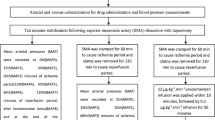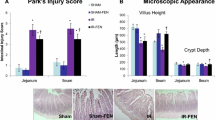Abstract
Purpose
Choline-containing dietary phospholipids, including phosphatidylcholine (PC), may function as anti-inflammatory substances, but the mechanism remains largely unknown. We investigated the effects of l-alpha-glycerylphosphorylcholine (GPC), a deacylated PC derivative, in a rodent model of small intestinal ischaemia–reperfusion (IR) injury.
Methods
Anaesthetized Sprague-Dawley rats were divided into control, mesenteric IR (45 min mesenteric artery occlusion, followed by 180 min reperfusion), IR with GPC pretreatment (16.56 mg kg−1 GPC i.v., 5 min prior to ischaemia) or IR with GPC post-treatment (16.56 mg kg−1 GPC i.v., 5 min prior to reperfusion) groups. Macrohaemodynamics and microhaemodynamic parameters were measured; intestinal inflammatory markers (xanthine oxidoreductase activity, superoxide and nitrotyrosine levels) and liver ATP contents were determined.
Results
The IR challenge reduced the intestinal intramural red blood cell velocity, increased the mesenteric vascular resistance, the tissue xanthine oxidoreductase activity, the superoxide production, and the nitrotyrosine levels, and the ATP content of the liver was decreased. Exogenous GPC attenuated the macro- and microcirculatory dysfunction and provided significant protection against the radical production resulting from the IR stress. The GPC pretreatment alleviated the hepatic ATP depletion, the reductions in the mean arterial pressure and superior mesenteric artery flow, and similarly to the post-treatments with GPC, also decreased the xanthine oxidoreductase activity, the intestinal superoxide production, the nitrotyrosine level, and normalized the microcirculatory dysfunction.
Conclusions
These data demonstrate the effectiveness of GPC therapies and provide indirect evidence that the anti-inflammatory effects of PC could be linked to a reaction involving the polar part of the molecule.








Similar content being viewed by others

References
Han JY, Fan JY, Horie Y, Miura S, Cui DH, Ishii H, Hibi T, Tsuneki H, Kimura I (2008) Ameliorating effects of compounds derived from Salvia miltiorrhiza root extract on microcirculatory disturbance and target organ injury by ischemia and reperfusion. Pharmacol Ther 117:280–295
Breithaupt-Faloppa AC, Fantozzi ET, Assis-Ramos MM, Vitoretti LB, Couto GK, Rossoni LV, Oliveira-Filho RM, Vargaftig BB, Tavares-de-Lima W (2013) Protective effect of estradiol on acute lung inflammation induced by an intestinal ischemic insult is dependent on nitric oxide. Shock 40:203–209. doi:10.1097/SHK.0b013e3182a01e24
Cuzzocrea S, Mazzon E, Esposito E, Muià C, Abdelrahman M, Di Paola R, Crisafulli C, Bramanti P, Thiemermann C (2007) Glycogen synthase kinase-3beta inhibition attenuates the development of ischaemia/reperfusion injury of the gut. Intensive Care Med 33:880–893
Mallick IH, Yang W, Winslet MC, Seifalian AM (2004) Ischemia-reperfusion injury of the intestine and protective strategies against injury. Dig Dis Sci 49:1359–1377
Wada K, Montalto MC, Stahl GL (2001) Inhibition of complement C5 reduces local and remote organ injury after intestinal ischemia/reperfusion in the rat. Gastroenterology 120:126–133
DeGraba TJ (1998) The role of inflammation after acute stroke: utility of pursuing anti-adhesion molecule therapy. Neurology 51:S62–S68
Sasaki M, Joh T (2007) Oxidative stress and ischemia-reperfusion injury in gastrointestinal tract and antioxidant, protective agents. J Clin Biochem Nutr 40:1–2. doi:10.3164/jcbn.40.1
Francischetti I, Moreno JB, Scholz M, Yoshida WB (2010) Leukocytes and the inflammatory response in ischemia-reperfusion injury. Rev Bras Cir Cardiovasc 25:575–584
Volinsky R, Kinnunen PK (2013) Oxidized phosphatidylcholines in membrane-level cellular signaling: from biophysics to physiology and molecular pathology. FEBS J 280:2806–2816. doi:10.1111/febs.12247
Stremmel W, Ehehalt R, Staffer S, Stoffels S, Mohr A, Karner M, Braun A (2012) Mucosal protection by phosphatidylcholine. Dig Dis 30(Suppl 3):85–91. doi:10.1159/000342729
Erős G, Ibrahim S, Siebert N, Boros M, Vollmar B (2009) Oral phosphatidylcholine pretreatment alleviates the signs of experimental rheumatoid arthritis. Arthritis Res Ther 11:R43. doi:10.1186/ar2651
Hartmann P, Szabó A, Erős G, Gurabi D, Horváth G, Németh I, Ghyczy M, Boros M (2009) Anti-inflammatory effects of phosphatidylcholine in neutrophil leukocyte-dependent acute arthritis in rats. Eur J Pharmacol 622:58–64. doi:10.1016/j.ejphar.2009.09.012
Treede I, Braun A, Jeliaskova P, Giese T, Füllekrug J, Griffiths G, Stremmel W, Ehehalt R (2009) TNF-alpha-induced up-regulation of pro-inflammatory cytokines is reduced by phosphatidylcholine in intestinal epithelial cells. BMC Gastroenterol 9:53. doi:10.1186/1471-230X-9-53
Tőkés T, Erős G, Bebes A, Hartmann P, Várszegi S, Varga G, Kaszaki J, Gulya K, Ghyczy M, Boros M (2011) Protective effects of a phosphatidylcholine-enriched diet in lipopolysaccharide-induced experimental neuroinflammation in the rat. Shock 36:458–465. doi:10.1097/SHK.0b013e31822f36b0
Erős G, Varga G, Váradi R, Czóbel M, Kaszaki J, Ghyczy M, Boros M (2009) Anti-inflammatory action of a phosphatidylcholine, phosphatidylethanolamine and N-acylphosphatidylethanolamine-enriched diet in carrageenan-induced pleurisy. Eur Surg Res 42:40–48. doi:10.1159/000167856
Bochkov VN, Kadl A, Huber J, Gruber F, Binder BR, Leitinger N (2002) Protective role of phospholipid oxidation products in endotoxin-induced tissue damage. Nature 419:77–81
Nivala AM, Reese L, Frye M, Gentile CL, Pagliassotti MJ (2013) Fatty acid-mediated endoplasmic reticulum stress in vivo: differential response to the infusion of Soybean and Lard Oil in rats. Metabolism 62:753–760. doi:10.1016/j.metabol.2012.12.001
Galazzini M, Burg MB (2009) What’s new about osmotic regulation of glycerophosphocholine. Physiology 24:245–249. doi:10.1152/physiol.00009.2009
Scribner DM, Witowski NE, Mulier KE, Lusczek ER, Wasiluk KR, Beilman GJ (2010) Liver metabolomic changes identify biochemical pathways in hemorrhagic shock. J Surg Res 164:e131–e139. doi:10.1016/j.jss.2010.07.046
Gera L, Varga R, Török L, Kaszaki J, Szabó A, Nagy K, Boros M (2007) Beneficial effects of phosphatidylcholine during hindlimb reperfusion. J Surg Res 139:45–50
Varga R, Gera L, Török L, Kaszaki J, Szabó A, Nagy K, Boros M (2006) Effects of phosphatidylcholine therapy after hindlimb ischemia and reperfusion. Magy Seb 59:429–436
Lamprech W, Trautschold I (1976) Adenosine 5-triphosphate. Determination with hexokinase and glucose 6-phosphate dehydrogenase. In: Bergmeyer HU (ed) Methods of enzymatic analysis, vol 4. Verlag Chemie Weinheim, Academic Press, New York, pp 2101–2109
Chen F, Cushion MT (1994) Use of an ATP bioluminescent assay to evaluate viability of Pneumocystis carinii from rats. J Clin Microbiol 32:2791–2800
Andreotti PE, Berthold F (1999) Application of a new high sensitivity luminometer for industrial microbiology and molecular biology. Luminescence 14:19–22
Ferdinandy P, Danial H, Ambrus I, Rothery RA, Schulz R (2000) Peroxynitrite is a major contributor to cytokine-induced myocardial contractile failure. Circ Res 87:241–247
Beckman JS, Parks DA, Pearson JD, Marshall PA, Freeman BA (1989) A sensitive fluorometric assay for measuring xanthine dehydrogenase and oxidase in tissues. Free Rad Biol Med 6:607–615
Berland T, Oldenburg WA (2008) Acute mesenteric ischemia. Curr Gastroenterol Rep 10:341–346
Eckstein HH (2003) Acute mesenteric ischemia. Resection or reconstruction? Chirurg 74:419–431
Liu P, Hock CE, Nagele R, Wong PY (1997) Formation of nitric oxide, superoxide, and peroxynitrite in myocardial ischemia-reperfusion injury in rats. Am J Physiol 272:H2327–H2336
Raffaello A, Rizzuto R (2011) Mitochondrial longevity pathways. Biochim Biophys Acta 1813:260–268. doi:10.1016/j.bbamcr.2010.10.007
Li Z, Vance DE (2008) Phosphatidylcholine and choline homeostatis. J Lipid Res 49:1187–1194. doi:10.1194/jlr.R700019-JLR200
Erős G, Kaszaki J, Czóbel M, Boros M (2006) Systemic phosphatidylcholine pretreatment protects canine esophageal mucosa during acute experimental biliary reflux. World J Gastroenterol 12:271–279
Ghyczy M, Torday C, Kaszaki J, Szabó A, Czóbel M, Boros M (2008) Oral phosphatidylcholine pretreatment decreases ischemia-reperfusion-induced methane generation and the inflammatory response in the small intestine. Shock 30:596–602. doi:10.1097/SHK.0b013e31816f204a
Ishikado A, Nishio Y, Yamane K, Mukose A, Morino K, Murakami Y, Sekine O, Makino T, Maegawa H, Kashiwagi A (2009) Soy phosphatidylcholine inhibited TLR4-mediated MCP-1 expression in vascular cells. Atherosclerosis 205:404–412. doi:10.1016/j.atherosclerosis.2009.01.010
Chao W, Spragg RG, Smith RM (1995) Inhibitory effect of porcine surfactant on the respiratory burst oxidase in human neutrophils. Attenuation of p47phox and p67phox membrane translocation as the mechanism. J Clin Invest 96:2654–2660
Zeplin PH, Larena-Avellaneda A, Jordan M, Laske M, Schmidt K (2010) Phosphorylcholine-coated silicone implants: effect on inflammatory response and fibrous capsule formation. Ann Plast Surg 65:560–564. doi:10.1097/SAP.0b013e3181d6e326
Onishchenko LS, Gaikova ON, Yanishevskii SN (2008) Changes at the focus of experimental ischemic stroke treated with neuroprotective agents. Neurosci Behav Physiol 38:49–54
Kidd PM (2009) Integrated brain restoration after ischemic stroke–medical management, risk factors, nutrients, and other interventions for managing inflammation and enhancing brain plasticity. Altern Med Rev 14:14–35
De Jesus Moreno Moreno M (2003) Cognitive improvement in mild to moderate Alzheimer’s dementia after treatment with the acetylcholine precursor choline alfoscerate: a multicenter, double-blind, randomized, placebo-controlled trial. Clin Ther 25:178–193
Alkondon M, Pereira EF, Cortes WS, Maelicke A, Albuquerque EX (1997) Choline is a selective agonist of alpha7 nicotinic acetylcholine receptors in the rat brain neurons. Eur J Neurosci 9:2734–2742
Guseva MV, Hopkins DM, Pauly JR (2006) An autoradiographic analysis of rat brain nicotinic receptor plasticity following dietary choline modification. Pharmacol Biochem Behav 84:26–34
Tribollet E, Bertrand D, Marguerat A, Raggenbass M (2004) Comparative distribution of nicotinic receptor subtypes during development, adulthood and aging: an autoradiographic study in the rat brain. Neuroscience 124:405–420
Nott A, Levin ED (2006) Dorsal hippocampal alpha7 and alpha4beta2 nicotinic receptors and memory. Brain Res 1081:72–78
Shytle RD, Mori T, Townsend K, Vendrame M, Sun N, Zeng J, Ehrhart J, Silver AA, Sanberg PR, Tan J (2004) Cholinergic modulation of microglial activation by alpha 7 nicotinic receptors. J Neurochem 89:337–343
Wang H, Yu M, Ochani M, Amella CA, Tanovic M, Susarla S, Li JH, Wang H, Yang H, Ulloa L, Al-Abed Y, Czura CJ, Tracey KJ (2003) Nicotinic acetylcholine receptor alpha7 subunit is an essential regulator of inflammation. Nature 421:384–388
Bernik TR, Friedman SG, Ochani M, DiRaimo R, Susarla S, Czura CJ, Tracey KJ (2002) Cholinergic antiinflammatory pathway inhibition of tumor necrosis factor during ischemia reperfusion. J Vasc Surg 36:1231–1236
Guarini S, Altavilla D, Cainazzo MM, Giuliani D, Bigiani A, Marini H, Squadrito G, Minutoli L, Bertolini A, Marini R, Adamo EB, Venuti FS, Squadrito F (2003) Efferent vagal fibre stimulation blunts nuclear factor–kappaB activation and protects against hypovolemic hemorrhagic shock. Circulation 107:1189–1194
Mioni C, Bazzani C, Giuliani D, Altavilla D, Leone S, Ferrari A, Minutoli L, Bitto A, Marini H, Zaffe D, Botticelli AR, Iannone A, Tomasi A, Bigiani A, Bertolini A, Squadrito F, Guarini S (2005) Activation of an efferent cholinergic pathway produces strong protection against myocardial ischemia/reperfusion injury in rats. Crit Care Med 33:2621–2628
van Westerloo DJ, Giebelen IA, Florquin S, Bruno MJ, Larosa GJ, Ulloa L, Tracey KJ, van der Poll T (2006) The vagus nerve and nicotinic receptors modulate experimental pancreatitis severity in mice. Gastroenterology 130:1822–1830
Tracey KJ (2002) The inflammatory reflex. Nature 420:853–859
Ghyczy M, Torday C, Kaszaki J, Szabó A, Czóbel M, Boros M (2008) Hypoxia-induced generation of methane in mitochondria and eukaryotic cells: an alternative approach to methanogenesis. Cell Physiol Biochem 21:251–258. doi:10.1159/000113766
Tuboly E, Szabó A, Garab D, Bartha G, Janovszky Á, Erős G, Szabó A, Mohácsi Á, Szabó G, Kaszaki J, Ghyczy M, Boros M (2013) Methane biogenesis during sodium azide-induced chemical hypoxia in rats. Am J Physiol Cell Physiol 304:C207–C214. doi:10.1152/ajpcell.00300.2012
Acknowledgments
The authors are grateful to Edina Markó, Nikolett Beretka, Csilla Mester, and Ágnes Lilla Kovács for their valuable assistance and to Károly Tóth and Kálmán Vas for their excellent work. The study was supported by the Országos Tudományos Kutatási Alapprogram (OTKA; Hungarian Science Research Fund) OTKA K104656, and Társadalmi Megújulás Operatív Program Konvergencia Régió (TAMOP-KONV; Social Renewal Operational Programme-Regional Convergence) TÁMOP-4.2.2A-11/1/KONV-2012-0073 and TAMOP-4.2.2A-11/1-KONV -2012-0035, supported by the European Union and the State of Hungary, co-financed by the European Social Fund in the framework of TÁMOP-4.2.4.A/2-11/1-2012-0001 ‘National Excellence Program’.
Conflict of interest
The authors declare that they have no conflict of interest.
Author information
Authors and Affiliations
Corresponding author
Additional information
Tünde Tőkés and Eszter Tuboly have contributed equally to this work.
Rights and permissions
About this article
Cite this article
Tőkés, T., Tuboly, E., Varga, G. et al. Protective effects of l-alpha-glycerylphosphorylcholine on ischaemia–reperfusion-induced inflammatory reactions. Eur J Nutr 54, 109–118 (2015). https://doi.org/10.1007/s00394-014-0691-2
Received:
Accepted:
Published:
Issue Date:
DOI: https://doi.org/10.1007/s00394-014-0691-2



